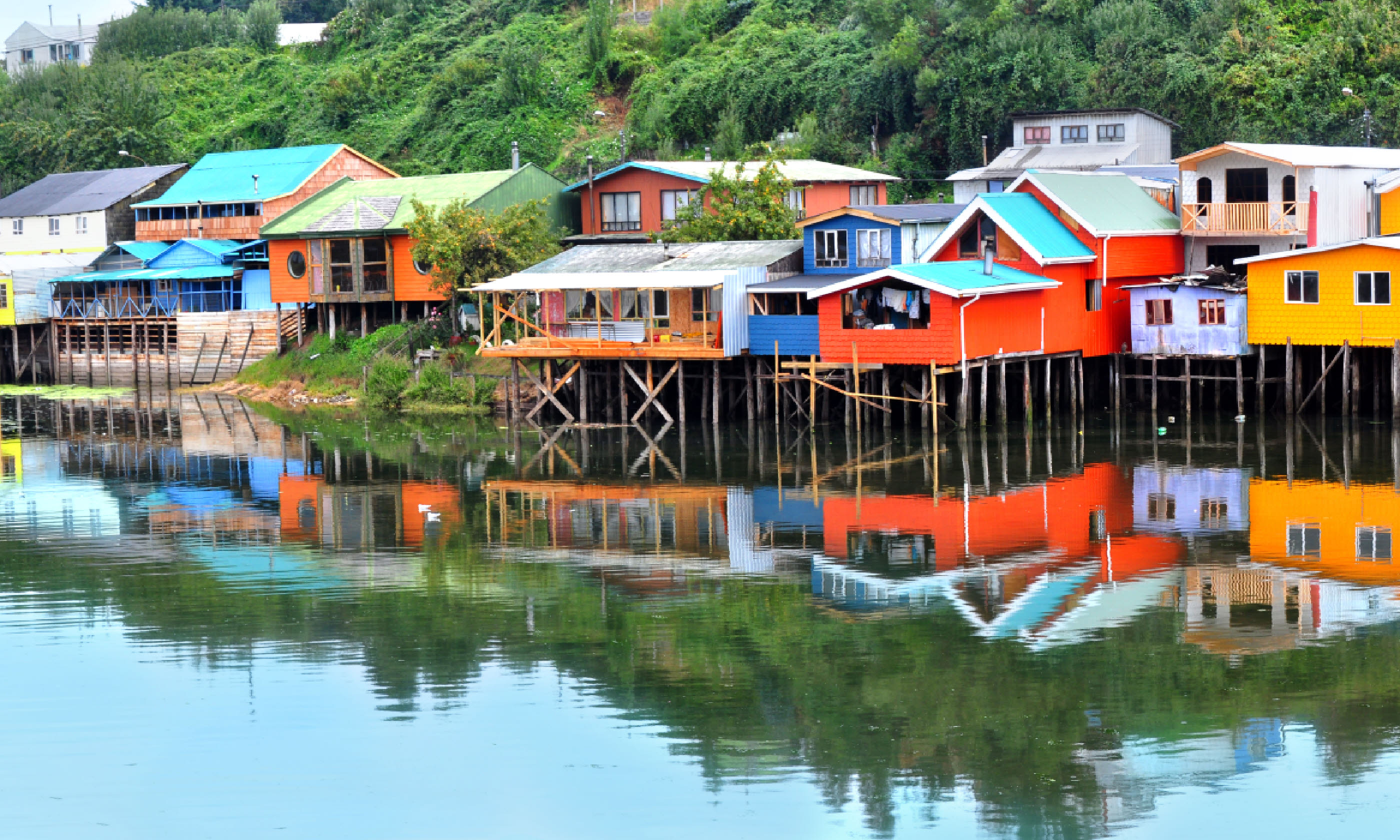
Island of legends: Exploring Chiloé, Chile
Northern Patagonia’s Chiloé archipelago is not only a fascinating land of historic churches, wild islets and prolific penguins – it’s also quite unlike anywhere else…
Pushing open the heavy wooden door of the shingled building in the grounds of Centro de Ocio Hotel, I was met by a timeless scene. Smoke rose from a deep fire pit, which was being used to roast meats, fish and potatoes. A family band started playing: charismatic Amigo Alex on vocals; his multi-talented son, William, switching between a variety of wind and stringed instruments; daughter Lucero played drums.
The songs were a mix of traditional Chilote numbers and their own compositions. On finding out that a member of our party was celebrating her birthday, Alex directed a song to her, before asking, “What does it feel like celebrating your birthday in the Republic of Chiloé?”
Chiloé certainly has its own strong identity. It is common to hear the locals say, “I am not Chilean, I am Chilote”. Incomers, whether from mainland Chile or other countries altogether, are even more passionate about it. The manager at the Centro de Ocio was typical. Born in Argentina, Nicholas had married a Chilote and had persuaded her to move back home. “I’m not from here, but it’s my island. I choose to live here. I am Chilote.”
Birds, beliefs and bluster
The Chiloé Archipelago lies a little over halfway down the coast of Chile, and is considered part of the Lake District region of northern Patagonia. The main island, a little smaller than Cornwall and Devon combined, is also called Chiloé. Sitting within the Roaring Forties, the archipelago is blasted with rain and high winds; weather so extreme that Darwin grumbled, ‘In winter the climate is detestable, and in summer it is only a little better.’
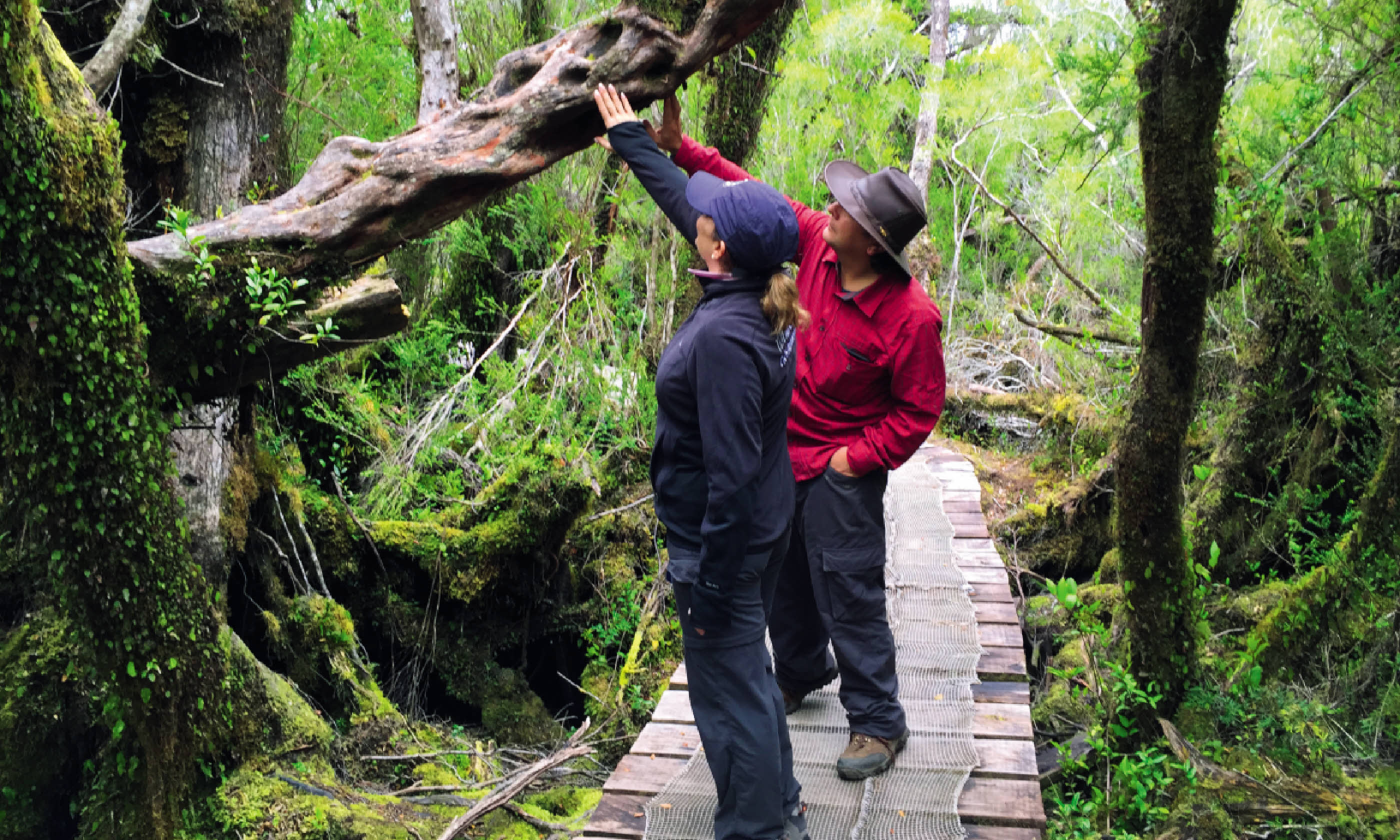 Chiloé National Park (Lyn Hughes)
Chiloé National Park (Lyn Hughes)
Driving through Chiloé was initially slightly disorientating. Small, green pastures were grazed by dairy cows and expanses of yellow broom flowered by the roadside. Along with the blustery weather, this gave it the feel of the Outer Hebrides or Ireland’s west coast. But it was the birdlife that indicated we were somewhere more exotic. Black-faced ibis prowled the fields, blacknecked swans glided around the estuaries and chimango caracaras sat sentinel on fence posts watching out for snacks.
The architecture was the next giveaway. Many of the older houses are made of distinctive wooden shingles, while in Chiloé’s capital, Castro, and some other waterside communities, colourful
palafitos (stilt houses) grace the waterfront. Then, once you meet the people, you realise that Chiloé has its own distinctive culture, and is very different to mainland Chile.
At the Chiloé National Park, a small museum gives a brief insight into the history, flora and fauna, legends and folklore of the archipelago. Guide Cyril explained that when the Spanish came to Chiloé they were more into mixing than conquering, and so a lot of beliefs blended. Hence, Chiloé has its own mythology of creation, involving two serpents, one good, one evil. They fight each other, which is why the tide comes in and out.
The origins of other characters were harder to explain. Take Trauco, an ugly troll who is guardian of the forest. He reputedly has the power to enchant women and even make them pregnant. He has proved to be a useful alibi. For instance, after the 1960 Great Chilean Earthquake, the strongest ever recorded, Chiloé was a disaster zone and many Chilote men left to find work. If their wives fell pregnant while they were away, Trauco was blamed.
Even today, there is a lingering belief in the old myths. Whenever I queried how Chilotes felt about them, I received a similar response: “People say they don’t believe... But there is something in it, isn’t there?”
Priests and potatoes
The enduring folklore seemed at odds with such a devoutly religious population – over 95% of Chilotes are Catholic. While the colonising Spanish left the south of Chile to the Mapuche Indians, they settled in Chiloé; it was their first port of call after passing through the Straits of Magellan. The Spanish would stop on the islands to make repairs and replenish their food stores. And they brought their religion with them.
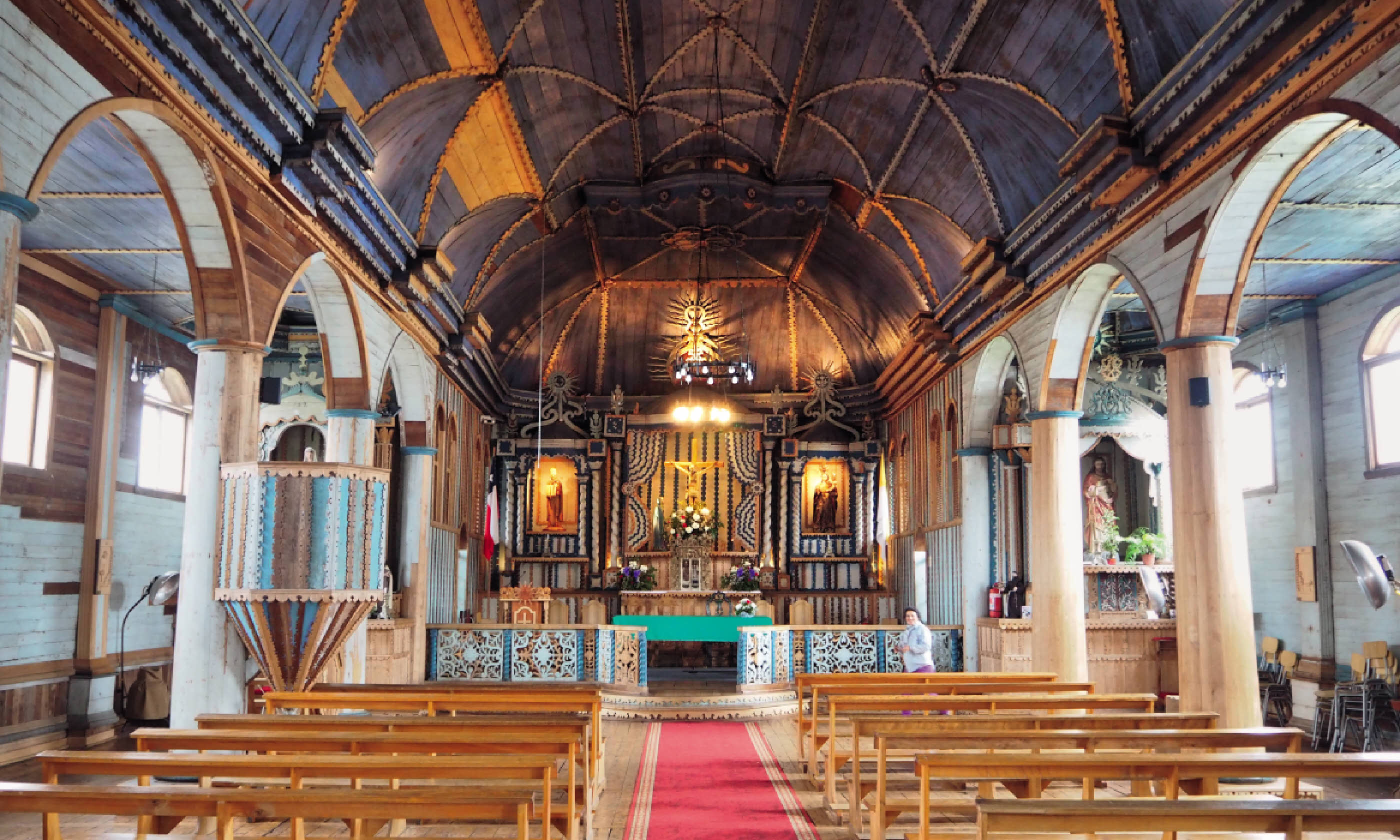 Tenaún church (Simon Heyes/Tierra Chiloé)
Tenaún church (Simon Heyes/Tierra Chiloé)
The Jesuits settled in Castro but undertook missions throughout the archipelago; they would make forays from September to March, when the weather is best. In 1767, the Jesuits were expelled and the Franciscans took over. They built more elaborate churches, constructing them from wood and without nails; they used joints that could withstand earth tremors, essential in a land where seismic activity is common.
Despite their clever design and Chiloé’s healthy Catholic population, many of the churches have been lost, destroyed by fire and wood-eating bugs. However, those that remain have been given Unesco World Heritage status. In the small coastal village of Tenaún the handsome three-towered 18th-century church has recently been restored. Architecturally it resembles an upside-down boat – as many of Chiloé’s churches do, as they were constructed by boat builders.
We walked down Tenaún’s dirt street to a small family restaurant, where a traditional
curanto was being prepared in a fire pit. A layer of seafood – mussels and clams – had been laid on the hot rocks, and then chunks of chicken, pork and sausages on top. Potatoes and two types of potato cake were added last. Finally the whole lot was covered with large leaves from the nalca plant, a type of wild rhubarb.
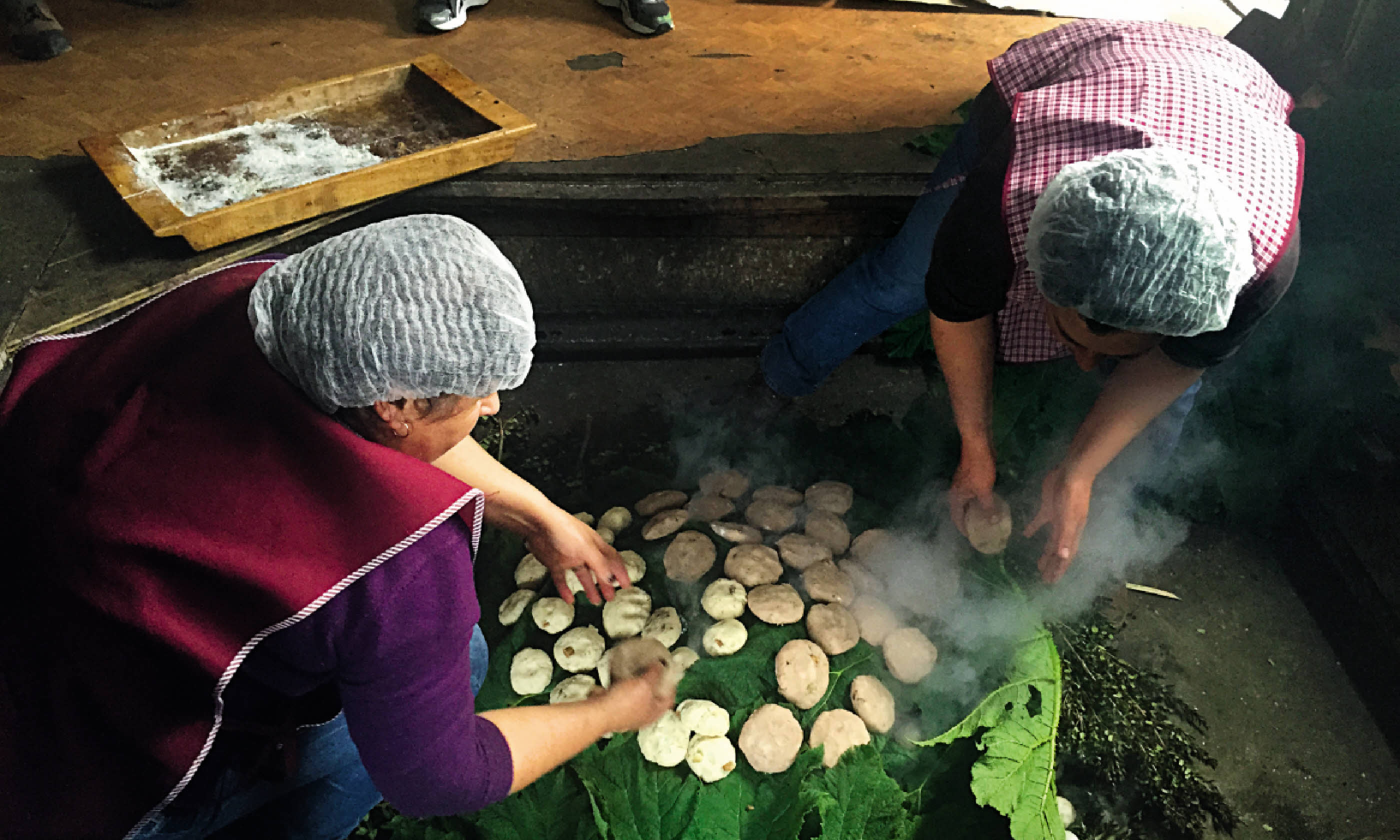 Cooking a curanto (Lyn Hughes)
Cooking a curanto (Lyn Hughes)
There were three types of potato, one of them a long, thin tuber with a nutty flavour. I asked what it was called but no one knew: “How can we, with so many varieties?” Chiloé reputedly has around 400 varieties of potato; a few years ago it was found that 90% of the world’s potatoes can be genetically traced back to Chiloé.
After an hour the curanto was uncovered, and the food piled into serving bowls, though before we headed to the table, we sat around the pit edge picking up the clams and mussels that had been left behind. Guide Cyril explained that food, whether from the land or sea, is easy to come by here. “You’d have to be lazy to starve! Plant a potato and it will grow in three months. And every tide brings more food.” Sure enough Tenaun’s pebbly beach was strewn with clam shells and crab claws.
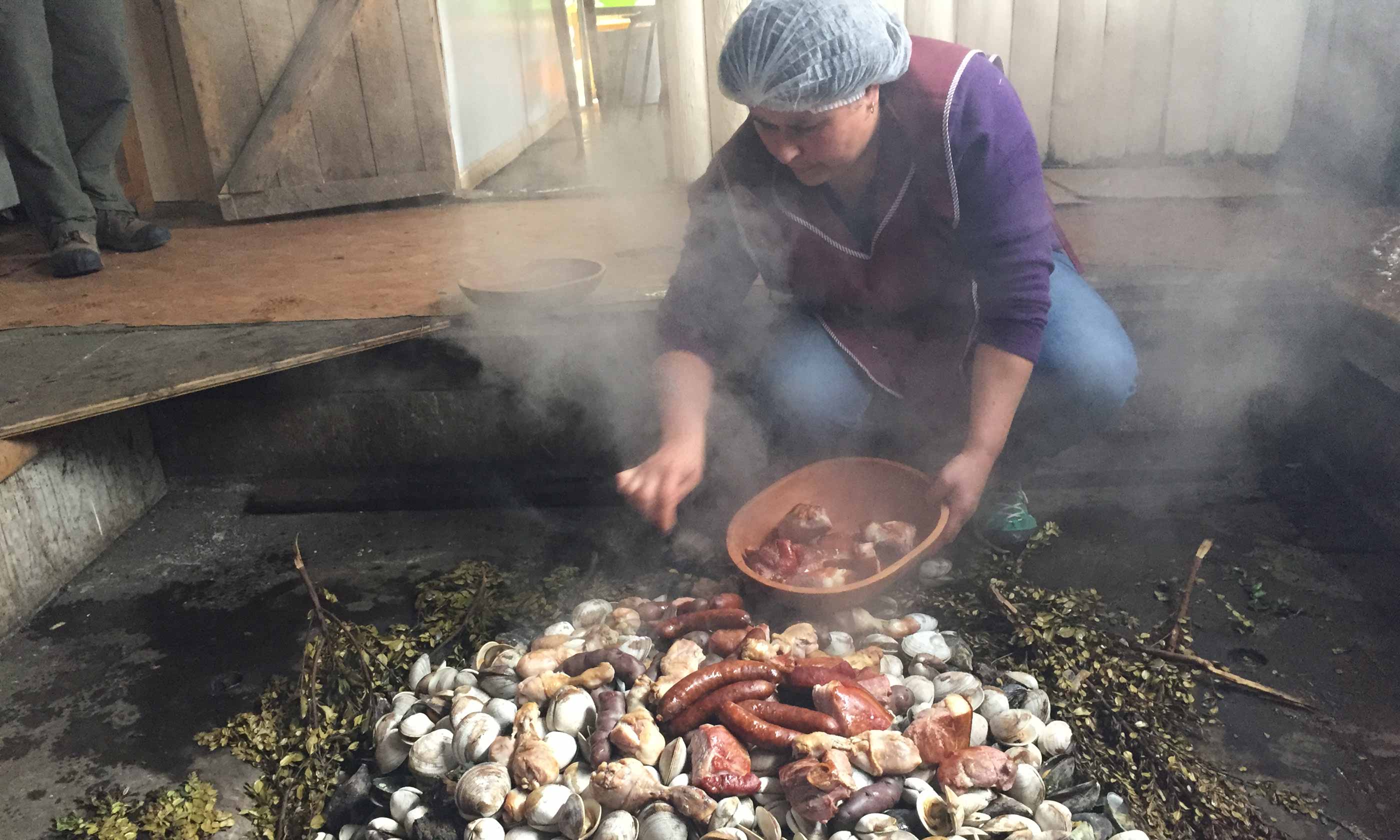
Uncovering a curanto (Lyn Hughes)
Bounty of birds
The bounty of the sea attracts plenty of other marine life, including whales. As Cyril boasted, “We have the largest and the smallest marine mammals here – blue whales and sea otters.” Neither are necessarily easily found, but visit Chiloé between September and March and you can be guaranteed penguin sightings.
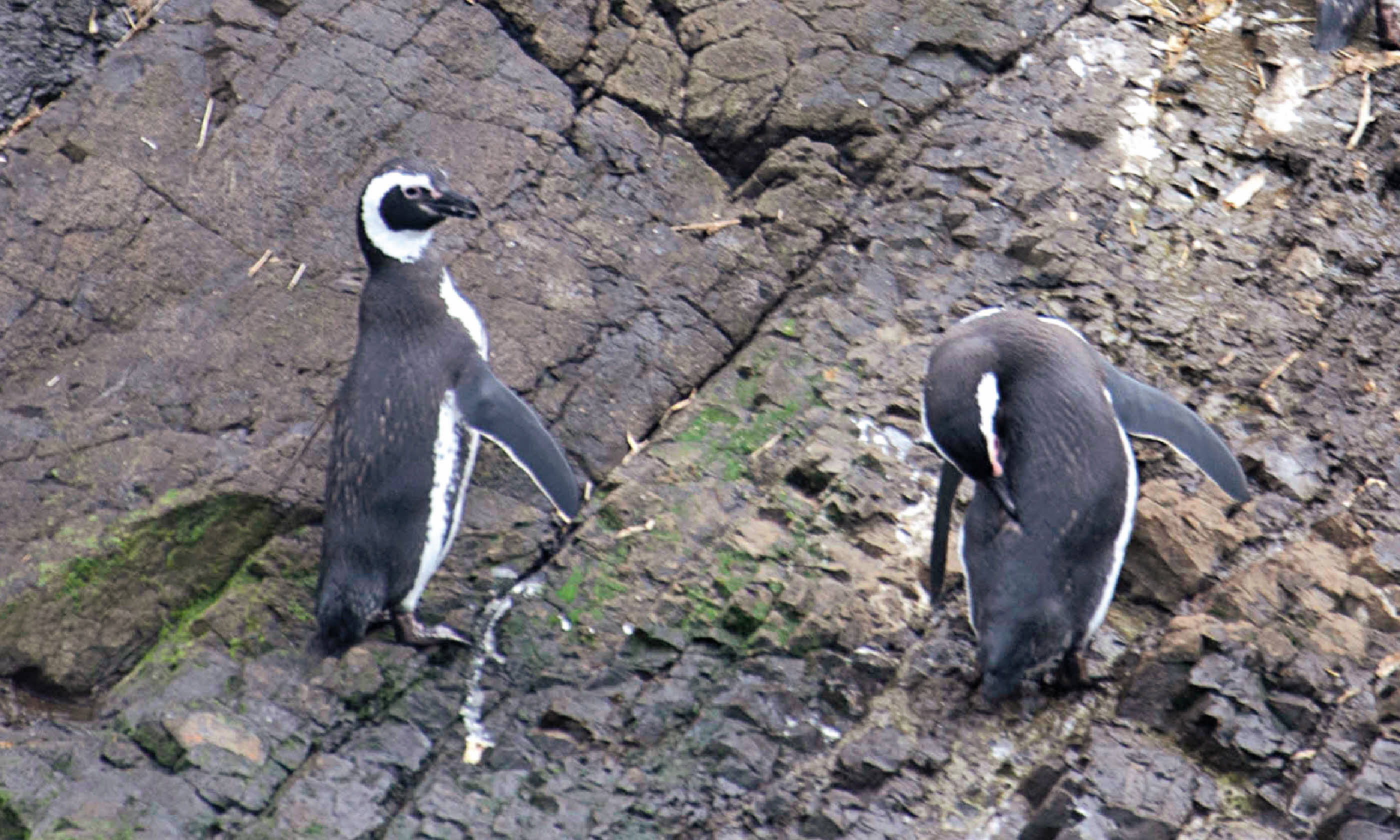 Penguins at Puñihuil Natural Monument (Lyn Hughes)
Penguins at Puñihuil Natural Monument (Lyn Hughes)
At Puñihuil Natural Monument, we walked along the beach and onto a wheeled platform that was pushed into the sea, enabling us to step onto a motorboat. The sky was heavy with leaden clouds as we zipped toward a group of rocky islets swarming with life. Pelicans, flightless steamer ducks, sea lions and four types of cormorant inhabited the rocks, while vultures soared overhead.
We marvelled at red-legged cormorants nesting on precariously narrow ledges set into a cliff face. Their nests are at risk of being predated on by gulls, so the cormorants find the most inaccessible spots they can; even their eggs are designed not to roll off. And then there were the penguins. This is the only place in the world where Magellanic and the endangered Humboldt penguin can be found nesting side by side. They were easy to tell apart: the more numerous Magellanics looking dapper in sleek black and white plumage; the Humboldts a grittier grey and white that blended with the rocks.
It was September, early in the season, so there were more of each species still to arrive. But there were enough for us to marvel at how they climbed the steep islets to their burrows.
Call of the wild
The next morning we were out on the water again, but this time kayaking through the Chepu River Valley. We had set out in pre-dawn darkness, slipping onto the confluence of the two rivers that combine to form the Chepu. Following the 1960 earthquake, and subsequent tsunami, the valley sank two metres, flooding a forest with salt water and killing the trees.
Today, the rivers are tidal, and we paddled our way upstream against the current. On higher ground to our left was typical temperate forest, but on our right were trees, bare of any vegetation, silhouetted starkly against the gradually lightening sky. After 40 minutes or so, we reached a sunken forest and paddled in silence through the eerie landscape of ghostly trunks. White egrets added to the ethereal scene; the only sounds were occasional birdcalls.
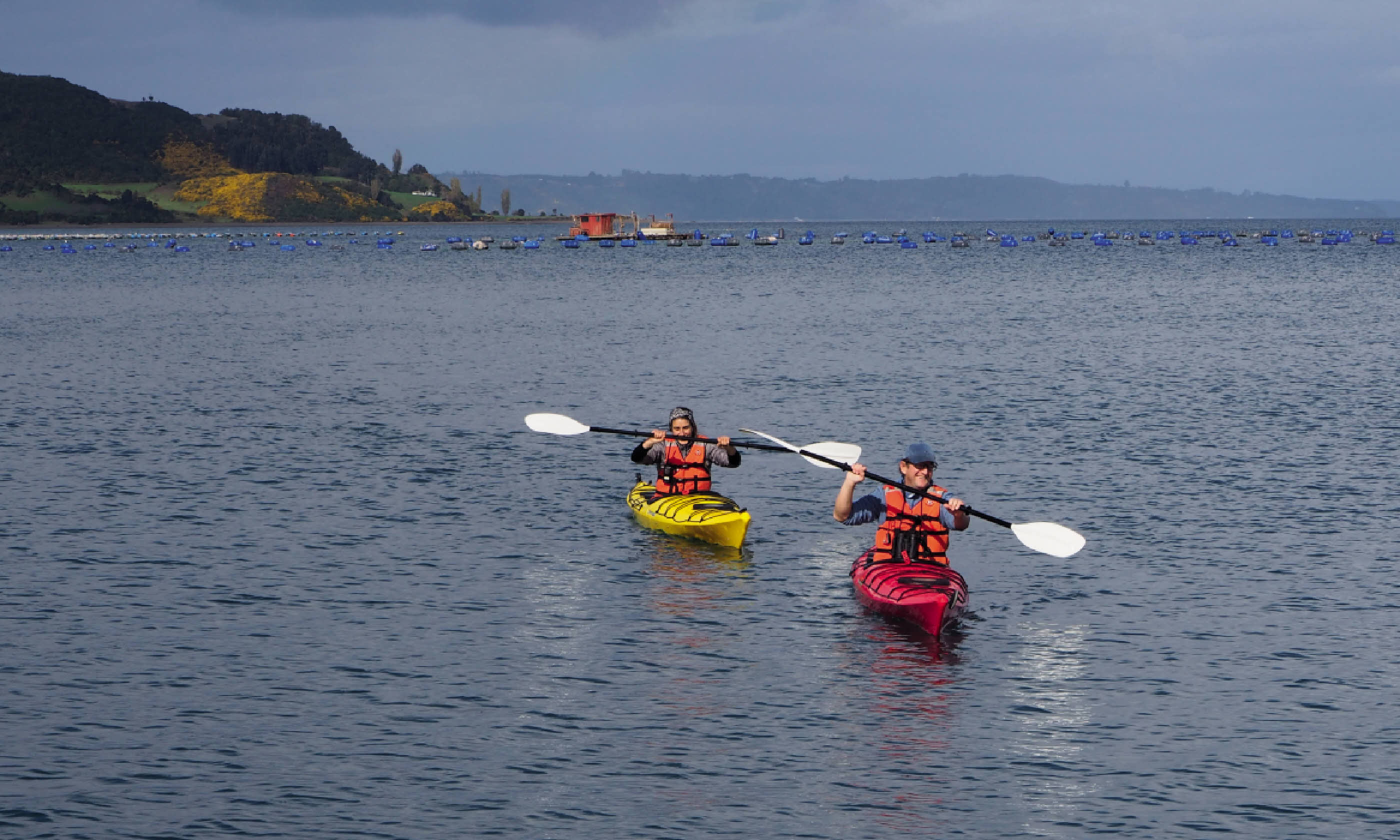 Kayaking on the coast (Simon Heyes/Tierra Chiloé)
Kayaking on the coast (Simon Heyes/Tierra Chiloé)
I saw a movement in the water, a trail, but whichever animal made it disappeared out of sight between some trees. “Probably an otter,” said Cyril. “We get both types here, the river and the sea otter. That may have been a sea otter coming up the river.” We turned back, hearing the roar of the nearby ocean and the distinctive call of a chucao.
We were relieved the little native forest bird was on our right-hand side. Legend has it that hearing it call on the right brings good luck; hearing it on the left means you have to turn around. The wind had changed, and now we were going with the current, so it was easy to fly through the water, back to Chepu Ecolodge. Fernando and Amory, owners of the lodge and the kayaking operation, were waiting for us.
Former city folk from Santiago, they now run a unique business that is a model of sustainability. The water comes from rain, and both water and power consumption is monitored by a central computer system. A tree is planted for every guest who stays, within certain targets. As Fernando matter-of-factly stated, “We are not just carbon neutral but carbon negative.”
The lodge is set high, with an enviable view over the valley and river confluence. “The light changes day by day, hour by hour,” Amory said. “It’s impossible to get tired of the view.” The couple talked with passion about the local environment, the folklore, the wildlife (their lodge’s lawn is grazed each evening by a pair of pudu, the world’s smallest deer) and the Chilote identity. Yet another pair of adopted Chilotes.
What a ride
The Spanish did leave a lasting legacy other than churches. When the conquistadors came to South America they brought horses. When they travelled over to Chiloé, they swam their horses alongside their boats. Today, the Chilote horses are believed to be the purest examples of these Spanish steeds left in the world.
Forget the glamorous Andalucían horses that are now associated with Spain. These are small, tough and stocky; practical little horses that could carry conquistadors over any terrain. They are still used as working animals. We had spotted them pulling carts or being ridden by farmers. We had even seen one being ridden after dark, its rider slumped over it in a traditional poncho: “If people get drunk they can just ride them home!”
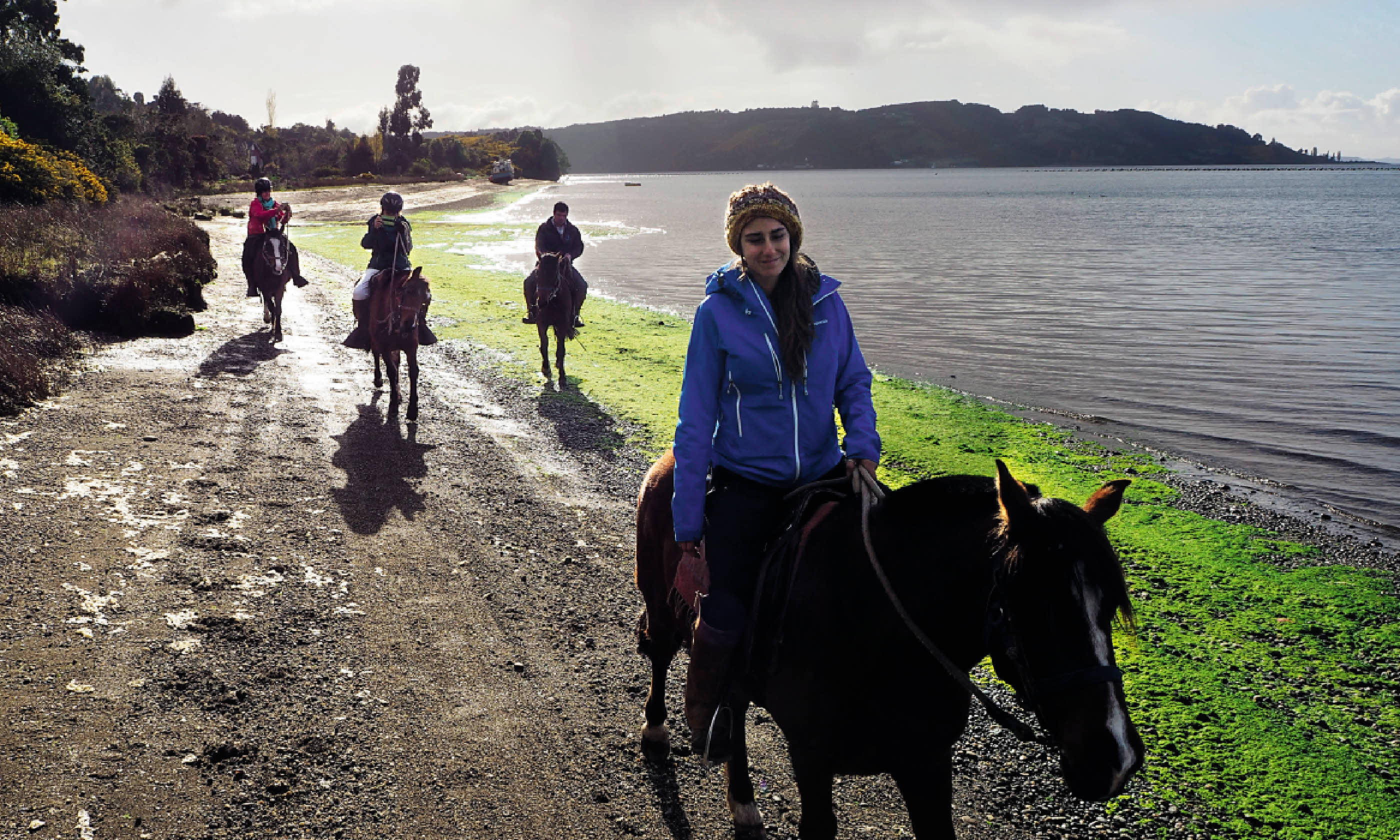 Riding along Chiloé's coast (Simon Heyes/Tierra Chiloé)
Riding along Chiloé's coast (Simon Heyes/Tierra Chiloé)
The Tierra Chiloé Hotel has its own horses, so I arranged a ride. A typical Chilote horse was brought to me and I asked his name. “Trauco,” came the answer. “Isn’t that the name of the ugly little goblin that makes women pregnant?” “Yes, that’s the one.” “Lucky, then, that I’m over child-bearing age!” I quipped. “Ah, but Trauco has magic powers. Anything could happen...”
Following horseman Don Juan (yes, that really was his name), I rode out of the hotel grounds and onto a small silvery beach, passing wetlands that attract migratory waders, including the rare Hudsonian godwit. We waved at a guest kayaking through the bay towards the hotel.
I caught up with him later, over a pisco sour. He was on a high. “We took a boat to Quinchao island, where I met the most amazing people before kayaking back. We saw penguins! And a porpoise!” It was my last night on Chiloé and, as the sun set over the bay and islands outside the picture windows, I cursed that I hadn’t allowed longer to explore the archipelago. But I did give thanks for one thing. Chiloé may have worked its magic on me, but fortunately Trauco had not.
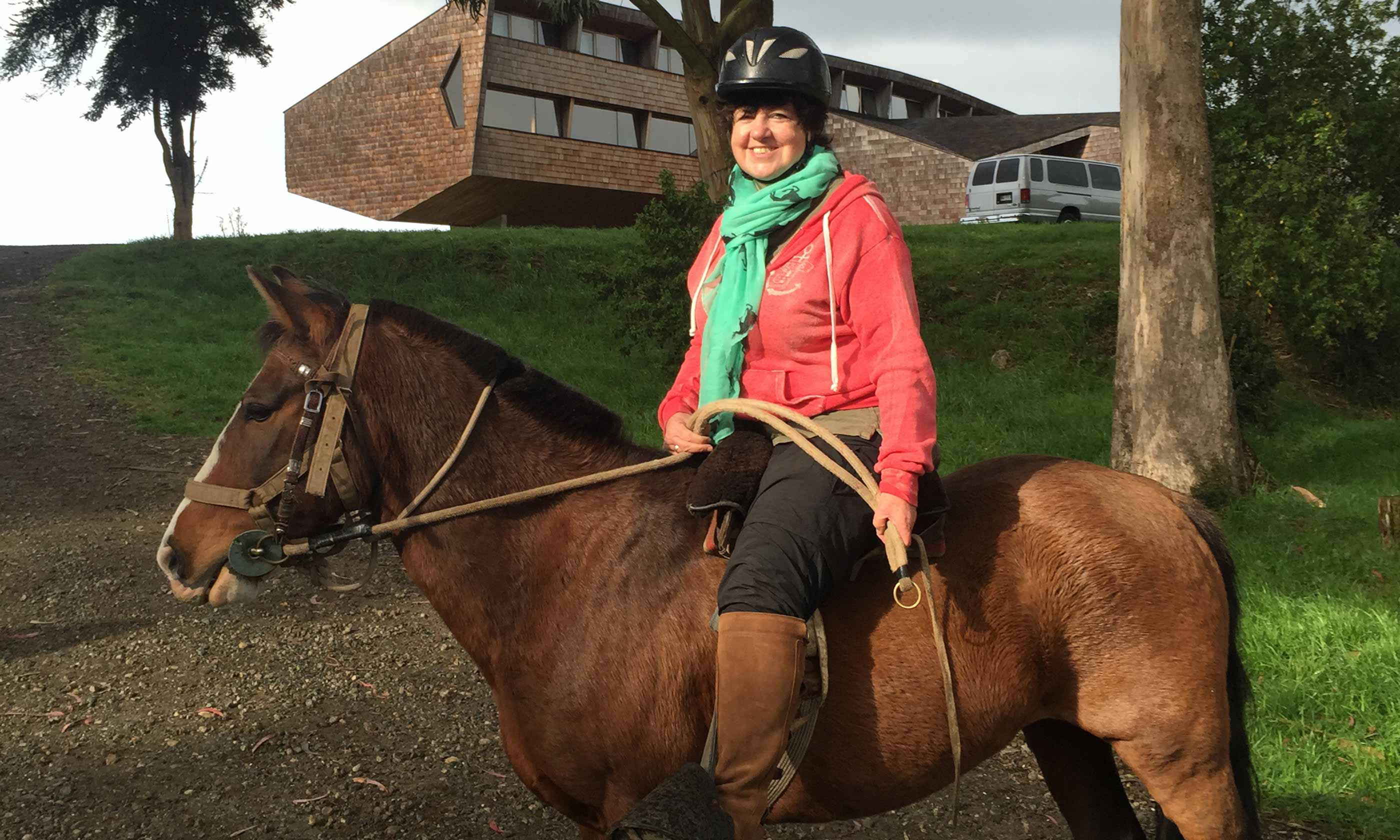
Lyn Hughes on Trauco the horse
Make it happen
The author travelled with
Chiloe Natural. Trips focus on Chiloé’s churches, culture and nature, are based at the Centro de Ocio hotel, and include a visit to the penguins.
Centro de Ocio (Rilán Peninsula) has 15 stylish rooms, ranging from impressive suites to lodge rooms. Activities available through Chiloé Natural. Doubles from US$189 (£125).
Tierra Chiloe (Rilán Peninsula) has just 12 rooms, all with the same impressive views over a bay. Activities are included – the hotel has a boat, kayaks and horses. Doubles from US$1,500 (£995) for two nights.
Hostel Palafito Cucao (Lake Cucao) offers simple yet stylish accommodation on the lakeshore, close to Chiloé National Park. Doubles from 48,000CLP (£45).
Chepu Adventures Lodge has won awards for its sustainability. Doubles from US$235 (£155), including kayaking; cheaper dorms available.








